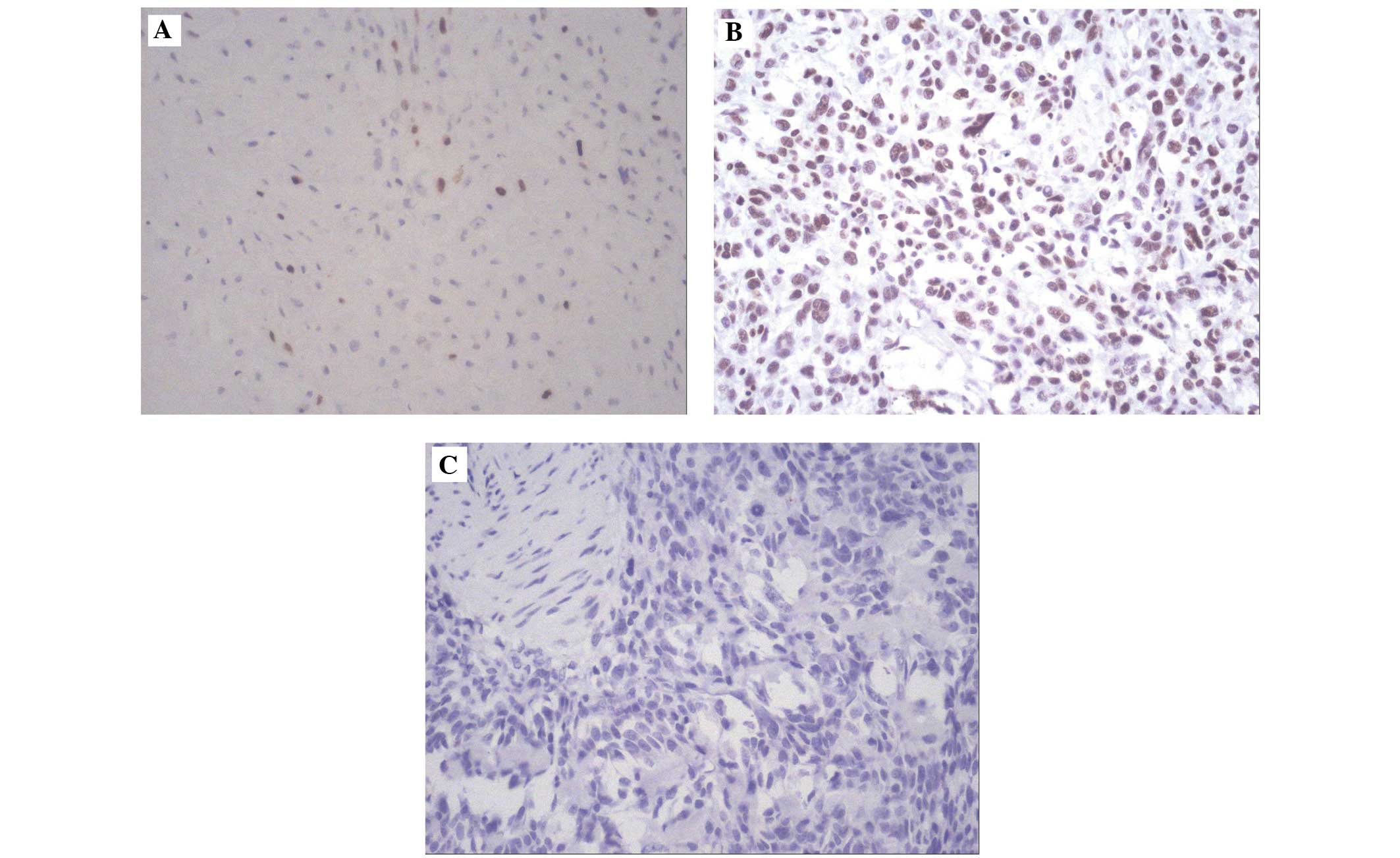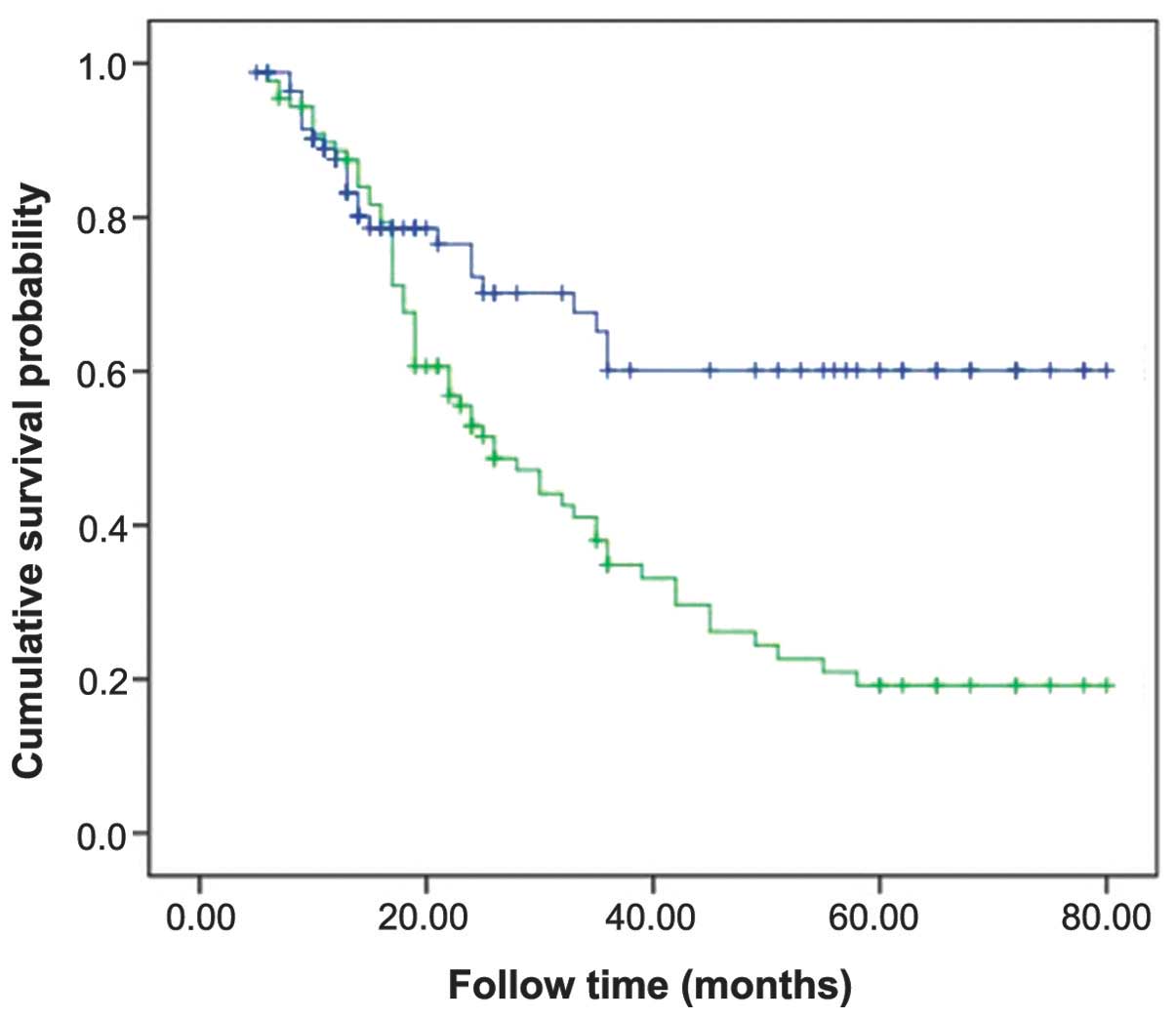|
1
|
Broadhead ML, Dass CR and Choong PF:
Systemically administered PEDF against primary and secondary
tumours in a clinically relevant osteosarcoma model. Br J Cancer.
105:1503–1511. 2011. View Article : Google Scholar : PubMed/NCBI
|
|
2
|
Mirabello L, Troisi RJ and Savage SA:
International osteosarcoma incidence patterns in children and
adolescents, middle ages and elderly persons. Int J Cancer.
125:229–234. 2009. View Article : Google Scholar : PubMed/NCBI
|
|
3
|
Cong Y, Li CJ, Zhao JN, Liu XZ and Shi X:
Associations of polymorphisms in the bone morphogenetic protein-2
gene with risk and prognosis of osteosarcoma in a Chinese
population. Tumour Biol. 36:2059–2064. 2015. View Article : Google Scholar : PubMed/NCBI
|
|
4
|
Zhang F, Huang W, Sheng M and Liu T:
MiR-451 inhibits cell growth and invasion by targeting CXCL16 and
is associated with prognosis of osteosarcoma patients. Tumour Biol.
36:2041–2048. 2015. View Article : Google Scholar : PubMed/NCBI
|
|
5
|
Briccoli A, Rocca M, Salone M, Guzzardella
GA, Balladelli A and Bacci G: High grade osteosarcoma of the
extremities metastatic to the lung: Long-term results in 323
patients treated combining surgery and chemotherapy, 1985–2005.
Surg Oncol. 19:193–199. 2010. View Article : Google Scholar : PubMed/NCBI
|
|
6
|
Bielack SS, Kempf-Bielack B, Delling G,
Exner GU, Flege S, Helmke K, Kotz R, Salzer-Kuntschik M, Werner M,
Winkelmann W, et al: Prognostic factors in high-grade osteosarcoma
of the extremities or trunk: An analysis of 1,702 patients treated
on neoadjuvant cooperative osteosarcoma study group protocols. J
Clin Oncol. 20:776–790. 2002. View Article : Google Scholar : PubMed/NCBI
|
|
7
|
Ren K, Yao N, Wang G, Tian L, Ma J, Shi X,
Zhang L, Zhang J, Zhou X, Zhou G, et al: Vasculogenic mimicry: A
new prognostic sign of human osteosarcoma. Hum Pathol.
45:2120–2129. 2014. View Article : Google Scholar : PubMed/NCBI
|
|
8
|
Seftor RE, Hess AR, Seftor EA, Kirschmann
DA, Hardy KM, Margaryan NV and Hendrix MJ: Tumor cell vasculogenic
mimicry: From controversy to therapeutic promise. Am J Pathol.
181:1115–1125. 2012. View Article : Google Scholar : PubMed/NCBI
|
|
9
|
Schmidt T and Carmeliet P: Angiogenesis: A
target in solid tumors, also in leukemia? Hematology Am Soc Hematol
Educ Program. 2011:1–8. 2011. View Article : Google Scholar : PubMed/NCBI
|
|
10
|
Fukumura D, Duda DG, Munn LL and Jain RK:
Tumor microvasculature and microenvironment: Novel insights through
intravital imaging in pre-clinical models. Microcirculation.
17:206–225. 2010. View Article : Google Scholar : PubMed/NCBI
|
|
11
|
Cao Z, Bao M, Miele L, Sarkar FH, Wang Z
and Zhou Q: Tumour vasculogenic mimicry is associated with poor
prognosis of human cancer patients: A systemic review and
meta-analysis. Eur J Cancer. 49:3914–3923. 2013. View Article : Google Scholar : PubMed/NCBI
|
|
12
|
Cao Z, Shang B, Zhang G, Miele L, Sarkar
FH, Wang Z and Zhou Q: Tumor cell-mediated neovascularization and
lymphangiogenesis contrive tumor progression and cancer metastasis.
Biochim Biophys Acta. 1836:273–286. 2013.PubMed/NCBI
|
|
13
|
Liu YR, Sun B, Zhao XL, Gu Q, Liu ZY, Dong
XY, Che N and Mo J: Basal caspase-3 activity promotes migration,
invasion, and vasculogenic mimicry formation of melanoma cells.
Melanoma Res. 23:243–253. 2013.PubMed/NCBI
|
|
14
|
Alexandrova EA and Beltchev BG: Acetylated
HMG1 protein interacts specifically with homologous DNA polymerase
alpha in vitro. Biochem Biophys Res Commun. 154:918–927.
1988. View Article : Google Scholar : PubMed/NCBI
|
|
15
|
Bonaldi T, Längst G, Strohner R, Becker PB
and Bianchi ME: The DNA chaperone HMGB1 facilitates
ACF/CHRAC-dependent nucleosome sliding. EMBO J. 21:6865–6873. 2002.
View Article : Google Scholar : PubMed/NCBI
|
|
16
|
Scaffidi P, Misteli T and Bianchi ME:
Release of chromatin protein HMGB1 by necrotic cells triggers
inflammation. Nature. 418:191–195. 2002. View Article : Google Scholar : PubMed/NCBI
|
|
17
|
Ellerman JE, Brown CK, de Vera M, Zeh HJ,
Billiar T, Rubartelli A and Lotze MT: Masquerader: High mobility
group box-1 and cancer. Clin Cancer Res. 13:2836–2848. 2007.
View Article : Google Scholar : PubMed/NCBI
|
|
18
|
Wang H, Vishnubhakat JM, Bloom O, Zhang M,
Ombrellino M, Sama A and Tracey KJ: Proinflammatory cytokines
(tumor necrosis factor and interleukin 1) stimulate release of high
mobility group protein-1 by pituicytes. Surgery. 126:389–392. 1999.
View Article : Google Scholar : PubMed/NCBI
|
|
19
|
Tang D, Kang R, Van Houten B, Zeh HJ,
Billiar TR and Lotze MT: High mobility group box 1 (HMGB1)
phenotypic role revealed with stress. Mol Med. 20:359–362. 2014.
View Article : Google Scholar : PubMed/NCBI
|
|
20
|
Luo Y, Chihara Y, Fujimoto K, Sasahira T,
Kuwada M, Fujiwara R, Fujii K, Ohmori H and Kuniyasu H: High
mobility group box 1 released from necrotic cells enhances regrowth
and metastasis of cancer cells that have survived chemotherapy. Eur
J Cancer. 49:741–751. 2013. View Article : Google Scholar : PubMed/NCBI
|
|
21
|
Tian J, Avalos AM, Mao SY, Chen B, Senthil
K, Wu H, Parroche P, Drabic S, Golenbock D, Sirois C, et al:
Toll-like receptor 9-dependent activation by DNA-containing immune
complexes is mediated by HMGB1 and RAGE. Nat Immunol. 8:487–496.
2007. View
Article : Google Scholar : PubMed/NCBI
|
|
22
|
Lin T, Sammy F, Yang H, Thundivalappil S,
Hellman J, Tracey KJ and Warren HS: Identification of hemopexin as
an anti-inflammatory factor that inhibits synergy of hemoglobin
with HMGB1 in sterile and infectious inflammation. J Immunol.
189:2017–2022. 2012. View Article : Google Scholar : PubMed/NCBI
|
|
23
|
Zhang G, Chen F, Cao Y, Amos JV, Shah G
and See WA: HMGB1 release by urothelial carcinoma cells in response
to Bacillus Calmette-Guérin functions as a paracrine factor to
potentiate the direct cellular effects of Bacillus Calmette-Guérin.
J Urol. 190:1076–1082. 2013. View Article : Google Scholar : PubMed/NCBI
|
|
24
|
Balch CM, Gershenwald JE, Soong SJ,
Thompson JF, Atkins MB, Byrd DR, Buzaid AC, Cochran AJ, Coit DG,
Ding S, et al: Final version of 2009 AJCC melanoma staging and
classification. J Clin Oncol. 27:61992009. View Article : Google Scholar : PubMed/NCBI
|
|
25
|
Fuhrman SA, Lasky LC and Limas C:
Prognostic significance of morphologic parameters in renal cell
carcinoma. Am J Surg Pathol. 6:655–663. 1982. View Article : Google Scholar : PubMed/NCBI
|
|
26
|
Broadhead ML, Clark JC, Myers DE, Dass CR
and Choong PF: The molecular pathogenesis of osteosarcoma: A
review. Sarcoma. 2011:9592482011. View Article : Google Scholar : PubMed/NCBI
|
|
27
|
Aragon-Ching JB and Maki RG: Treatment of
adult soft tissue sarcoma: Old concepts, new insights, and
potential for drug discovery. Cancer Invest. 30:300–308. 2012.
View Article : Google Scholar : PubMed/NCBI
|
|
28
|
Mirabello L, Troisi RJ and Savage SA:
Osteosarcoma incidence and survival rates from 1973 to 2004: Data
from the Surveillance, Epidemiology, and End Results Program.
Cancer. 115:1531–1543. 2009. View Article : Google Scholar : PubMed/NCBI
|
|
29
|
Kong C and Hansen MF: Biomarkers in
osteosarcoma. Expert Opin Med Diagn. 3:13–23. 2009. View Article : Google Scholar : PubMed/NCBI
|
|
30
|
Laverdiere C, Hoang BH, Yang R, Sowers R,
Qin J, Meyers PA, Huvos AG, Healey JH and Gorlick R: Messenger RNA
expression levels of CXCR4 correlate with metastatic behavior and
outcome in patients with osteosarcoma. Clin Cancer Res.
11:2561–2567. 2005. View Article : Google Scholar : PubMed/NCBI
|
|
31
|
Somers GR, Ho M, Zielenska M, Squire JA
and Thorner PS: HER2 amplification and overexpression is not
present in pediatric osteosarcoma: A tissue microarray study.
Pediatr Dev Pathol. 8:525–532. 2005. View Article : Google Scholar : PubMed/NCBI
|
|
32
|
Osaka E, Suzuki T, Osaka S, Yoshida Y,
Sugita H, Asami S, Tabata K, Hemmi A, Sugitani M, Nemoto N and Ryu
J: Survivin as a prognostic factor for osteosarcoma patients. Acta
Histochem Cytochem. 39:95–100. 2006. View Article : Google Scholar : PubMed/NCBI
|
|
33
|
Shen X, Hong L, Sun H, Shi M and Song Y:
The expression of high-mobility group protein box 1 correlates with
the progression of non-small cell lung cancer. Oncol Rep.
22:535–539. 2009.PubMed/NCBI
|
|
34
|
Liu F, Zhang Y, Peng Z, Gao H, Xu L and
Chen M: High expression of high mobility group box 1 (hmgb1)
predicts poor prognosis for hepatocellular carcinoma after curative
hepatectomy. J Transl Med. 10:1352012. View Article : Google Scholar : PubMed/NCBI
|
|
35
|
Chuangui C, Peng T and Zhentao Y: The
expression of high mobility group box 1 is associated with lymph
node metastasis and poor prognosis in esophageal squamous cell
carcinoma. Pathol Oncol Res. 18:1021–1027. 2012. View Article : Google Scholar : PubMed/NCBI
|
|
36
|
Chen J, Xi B, Zhao Y, Yu Y, Zhang J and
Wang C: High-mobility group protein B1 (HMGB1) is a novel biomarker
for human ovarian cancer. Gynecol Oncol. 126:109–117. 2012.
View Article : Google Scholar : PubMed/NCBI
|
|
37
|
Liu Y, Xie C, Zhang X, Huang D, Zhou X,
Tan P, Qi L, Hu G, Tian Y and Qiu Y: Elevated expression of HMGB1
in squamous-cell carcinoma of the head and neck and its clinical
significance. Eur J Cancer. 46:3007–3015. 2010. View Article : Google Scholar : PubMed/NCBI
|
|
38
|
Hao Q, Du XQ, Fu X and Tian J: Expression
and clinical significance of HMGB1 and RAGE in cervical squamous
cell carcinoma. Zhonghua Zhong Liu Za Zhi. 30:292–295. 2008.(In
Chinese). PubMed/NCBI
|
|
39
|
Kang HJ, Lee H, Choi HJ, Youn JH, Shin JS,
Ahn YH, Yoo JS, Paik YK and Kim H: Non-histone nuclear factor HMGB1
is phosphorylated and secreted in colon cancers. Lab Invest.
89:948–959. 2009. View Article : Google Scholar : PubMed/NCBI
|
|
40
|
Topalova D, Ugrinova I, Pashev IG and
Pasheva EA: HMGB1 protein inhibits DNA replication in vitro:
A role of the acetylation and the acidic tail. Int J Biochem Cell
Biol. 40:1536–1542. 2008. View Article : Google Scholar : PubMed/NCBI
|
|
41
|
Schlueter C, Weber H, Meyer B, Rogalla P,
Röser K, Hauke S and Bullerdiek J: Angiogenetic signaling through
hypoxia: HMGB1: an angiogenetic switch molecule. Am J Pathol.
166:1259–1263. 2005. View Article : Google Scholar : PubMed/NCBI
|
|
42
|
Sitohy B, Nagy JA and Dvorak HF:
Anti-VEGF/VEGFR therapy for cancer: Reassessing the target. Cancer
Res. 72:1909–1914. 2012. View Article : Google Scholar : PubMed/NCBI
|
|
43
|
Wang W, Jiang H, Zhu H, Zhang H, Gong J,
Zhang L and Ding Q: Overexpression of high mobility group box 1 and
2 is associated with the progression and angiogenesis of human
bladder carcinoma. Oncol Lett. 5:884–888. 2013.PubMed/NCBI
|
|
44
|
Tang D, Kang R, Zeh HJ III and Lotze MT:
High-mobility group box 1 and cancer. Biochim Biophys Acta.
1799:131–140. 2010. View Article : Google Scholar : PubMed/NCBI
|
|
45
|
Xiao J, Ding Y, Huang J, Li Q, Liu Y, Ni
W, Zhang Y, Zhu Y, Chen L and Chen B: The association of HMGB1 gene
with the prognosis of HCC. PLoS One. 9:e890972014. View Article : Google Scholar : PubMed/NCBI
|
|
46
|
Yonemoto T, Tatezaki S, Ishii T, Satoh T,
Kimura H and Iwai N: Prognosis of osteosarcoma with pulmonary
metastases at initial presentation is not dismal. Clin Orthop Relat
Res. 349:194–199. 1998. View Article : Google Scholar : PubMed/NCBI
|
|
47
|
Daw NC, Billups CA, Rodriguez-Galindo C,
McCarville MB, Rao BN, Cain AM, Jenkins JJ, Neel MD and Meyer WH:
Metastatic osteosarcoma. Cancer. 106:403–412. 2006. View Article : Google Scholar : PubMed/NCBI
|
















